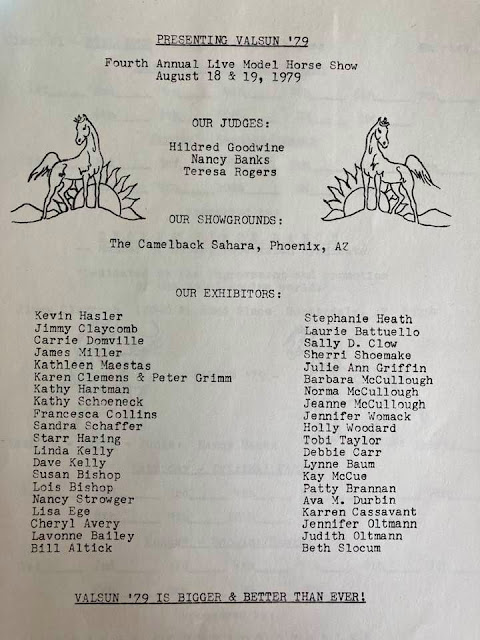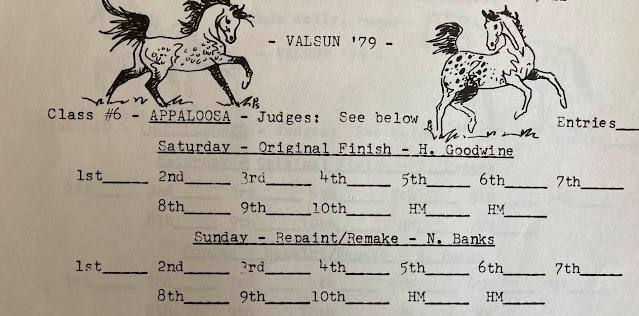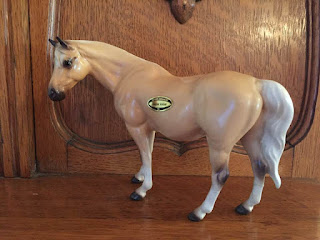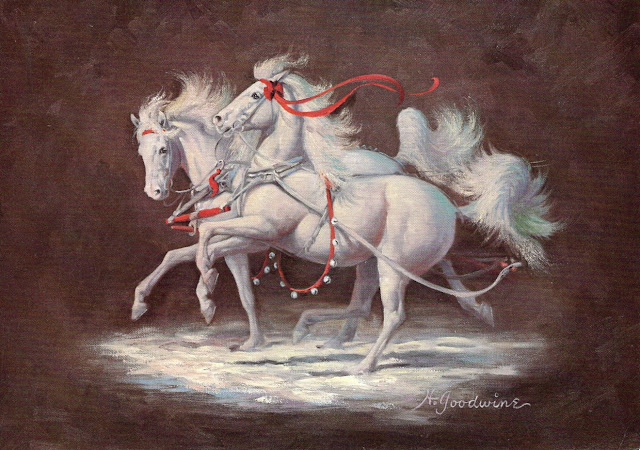 |
| Equine artist and model horse collector Hildred Goodwine |
In her 1999 book The Happy Horses of H. Goodwine, author Barbara Robinson gives a colorful and informative overview of the life and career of Arizona equine artist Hildred Goodwine (Hildred R. Goodwine-Phillips, 1918-1998). Hildred is best remembered as a painter of horses. In 1989, she was an Honoree of the National Cowgirl Museum and Hall of Fame. Countless images of Hildred's work were reproduced on greeting cards, stationery, gift wrap, postcards, and jigsaw puzzles by Leanin' Tree and other companies. Still other paintings that have never been reproduced are owned by private collectors; she also created murals for Wall Drug in South Dakota.
Robinson's book mentions that Hildred Goodwine also owned several hundred model horse figurines. What it doesn't say is that Hildred once participated in a large model horse event in Phoenix, created one-of-a-kind model horses out of Sculpey, and even looked into designing model horses for commercial release!
Let's get started by looking at some of Hildred's greeting card images.
Self-taught, Hildred painted horses of many breeds -- and no particular breed -- during her career. When After her first husband, Jim, passed away in 1965, she supported herself and her children through her art.
Many people associate Hildred's art with Christmas card designs.
Hildred also produced cover art for magazines including Western Horseman and Appaloosa News.
Within the last few months I've been fortunate enough to acquire cards, letters, and photographs from the collections of two model horse collectors who knew and corresponded with Hildred in the 1980s and early 1990s.
Linda Kelly (later Linda Myron), who lived in Phoenix, AZ and Galesburg, IL and Nancy (Mongan) Falzone of Oregon, IL corresponded with Hildred. Over time, both of these avid model horse collectors traded for and purchased Hildred's paintings, Sculpey horse figurines, and commercially produced model horses by other artists.
In her book, Robinson mentions that Hildred had a large model horse collection. Nancy Falzone was gracious enough to let me acquire her collection of Hildred's notecards. With that collection were some photos of Hildred's model horses and a drop-dead-gorgeous large carousel horse.
These photos, taken sometime between the 1980s and early 1990s, are enough to make practically any vintage model horse enthusiast swoon.
 |
| Hildred's large carousel horse. |
When my dear friend Linda (Kelly) Myron passed away in 2020, I was given her collection of correspondence with Hildred. In one of her notes to Linda, Hildred used an expression that I'm sure she got from Linda. It made me remember the early days of the organized model horse hobby, and that deserves some space here.
Linda and I were co-founders, along with Karen Pate, of the Valley of the Sun Model Horse Association in Phoenix -- ValSun for short. It was one of several regional groups of model horse collectors that sprang up around the country during the 1970s. We sought out new members by setting up booths full of model horses at local swap meets, through the lists of collectors that Breyer Model Horses used to distribute back then, and through hobby publications like the Model Horse Showers' Journal.
Linda was one of the kindest people the hobby ever knew. Small groups of ValSun members used to meet regularly at her apartment to talk and buy and sell and trade model horses. When Linda and I would talk on the phone, setting up another get-together, she would inevitably tell me to "bring tradin' stock!" These were model horses we were willing to trade for others. Each of us would set our available models on Linda's table, then we would sit around the table and stare and stare at the horses in total silence for minutes at a time, trying to guess what the other collector(s) would want in trade. (You could almost hear the theme music from "Jeopardy!" in the background. :) )
Linda was a huge admirer of Hildred Goodwine's art, and at some point the two connected. Linda visited Hildred on several occasions, even staying overnight in Hildred's trailer once with a couple of other ValSun members. Hildred even volunteered to help judge our big annual show in August 1979. Karen Pate recently sent me this copy of the show program.
 |
| ValSun 1979 show program. The artwork was by Nancy Strowger. |
 |
Exhibitors list, ValSun '79. The level of excellence at this show
was over-the-top, even for that day. And it was so much fun to have visiting showers from the West Coast, Southwest, and Midwest there. (Brave souls, to visit Phoenix in August.) |
 |
| Hildred served as judge for about 1/3 of the classes. It was good to have her perspective as a model horse collector and (real) horsewoman, even though she wasn't regularly involved in the hobby. |
 |
| The performance classes were where having Hildred as a judge, really paid off. As at many live shows, Nancy Banks, Hildred and I conferred on some of the placings. Hildred could tell if tack, particularly harness, was accurate and properly placed on the model, much better than many of the participating hobbyists. It was like taking a master class in making a model horse more realistic, for many of us! This was particularly important in the days before the internet allowed us to share such information widely and easily. |
(Yes, I will have to do a separate blog post on ValSun!)
In addition to collecting and once judging a model horse show, Hildred loved to trade with other people for her art. Linda Kelly (Myron) bought and traded for several pieces of Hildred's art over the years, and traded a couple of model horses from her as well. A December 1989 Christmas card from Hildred to Linda has a note inside; they were setting up another model horse trade.
"I'd be very happy to trade with you. I'd like the Cybis Appaloosa foal; in fact all [the model horses] you mentioned interest me.... Please come when you can. We have plenty of room for guests. Bring tradin' stock!!!"
So Hildred had adopted Linda's favorite expression for model horse trading.
Notes from Hildred to Linda and Nancy say that, at one point, her own collection was on display in a museum in Wickenburg, AZ, but a 1993 note says that she was putting them back on display in her home. Barbara's book says that Hildred's second husband Floyd had built a special room for them, but Hildred still had some of them packed away for lack of space.
Hildred was well known for her bronze sculptures of horses. And she also designed horse figurines using the polymer material Sculpey. Here are a few.
 |
These horses in harness were said to be in a museum in Wickenburg, Arizona,
when the photo was taken in the 1980s. |
As far as I've been able to determine, none of Hildred's model horse designs was ever commercially produced. This 21 July 1977 article in the Alliance, Nebraska Times-Herald newspaper shows Hildred using Sculpey to design horse figurines. It concludes by saying she was negotiating with a Denver toy company to have the sculptures mass-produced for hobbyists.
I haven't been able to learn what happened to Hildred's model horse collection after she passed away in 1998. Hopefully they are with people who appreciate them as much as she did.
The story of Hildred Goodwine's model horse collection, and her interactions with hobbyists, is an example of the fact that not everyone who collects model horses is active or well-known to the organized model horse hobby community.
I have more information to share about Hildred Goodwine and her art, but it will have to wait for another blog post. Stay tuned!
































